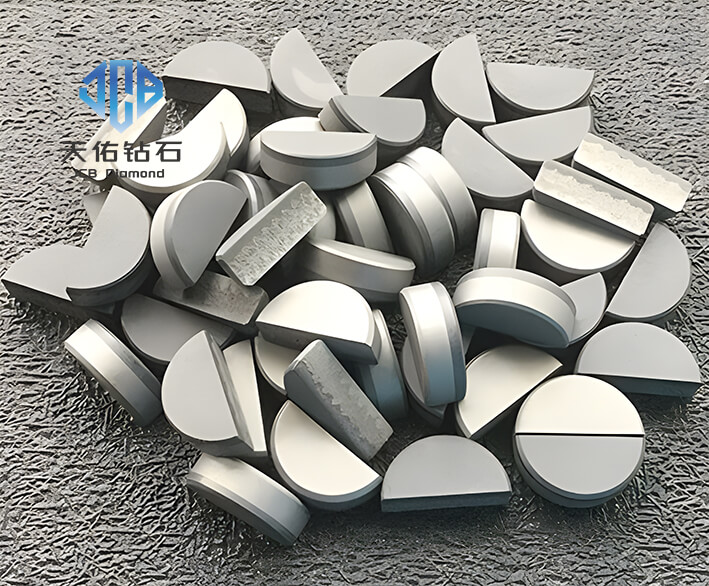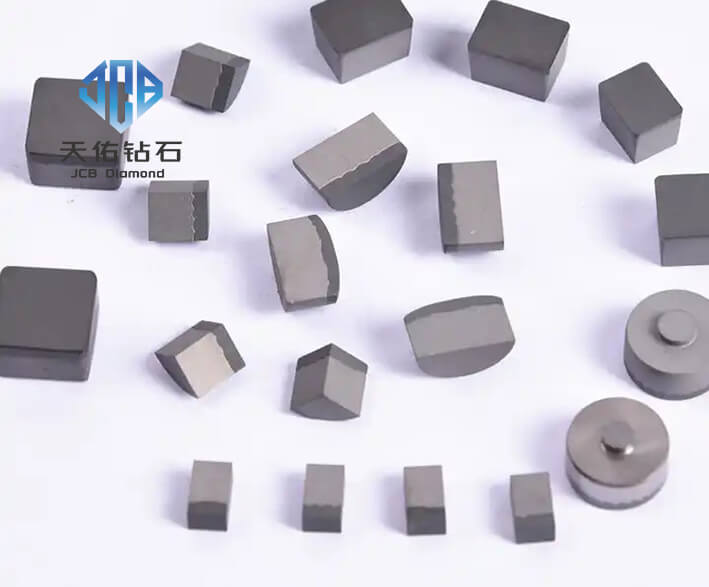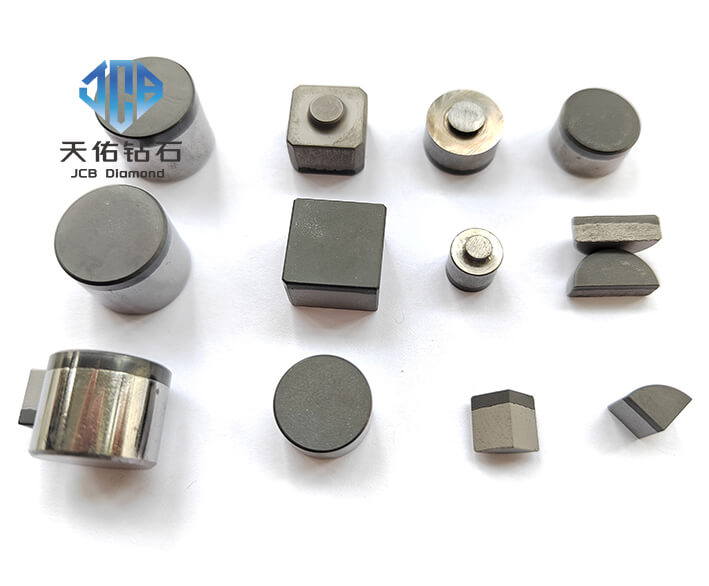Abstract: This study systematically analyzed and tested PDC (polycrystalline diamond composite sheet) stone composite sheet, aiming to explore its performance characteristics, preparation process, application effect and development potential in the field of stone processing. Through experimental research and actual application case analysis, the advantages and limitations of PDC stone composite sheet compared with traditional stone processing tools are revealed, and suggestions are put forward for its future development direction.
I. Introduction
With the continuous development of the stone processing industry, the demand for efficient and durable processing tools is increasing. As a new type of superhard material tool, PDC stone composite sheet has received widespread attention and application in the field of stone processing due to its excellent wear resistance, hardness and cutting performance. In-depth research on the performance and application of PDC stone composite sheet is of great significance to improve stone processing efficiency, reduce costs and promote technological progress in the stone industry.
II. Structure and principle of PDC stone composite sheet
(I) Structural composition
PDC stone composite sheet is usually composed of polycrystalline diamond layer and cemented carbide substrate. The polycrystalline diamond layer is formed by sintering numerous tiny diamond grains under high temperature and high pressure. It has extremely high hardness and wear resistance and directly contacts the stone for cutting operations. The carbide substrate provides good support and toughness for the diamond layer, ensuring the stability and impact resistance of the composite sheet during processing.
(II) Cutting principle
During the stone processing process, the diamond cutting edge of the PDC composite sheet removes the stone material by extrusion, shearing and scratching the stone surface to achieve the processing purposes such as cutting and grinding. Its high-hardness diamond layer can effectively overcome the hardness of the stone. At the same time, due to the presence of the carbide substrate, the composite sheet can withstand a certain cutting force and impact force to ensure the smooth progress of the cutting process.

III. Performance research of PDC composite sheet for stone
(I) Hardness and wear resistance test
The hardness of the PDC composite sheet for stone was measured by the Rockwell hardness test method, and the wear of the PDC composite sheet and the traditional carbide tool were compared through a simulated stone cutting experiment. The results show that the hardness of the PDC composite sheet is significantly higher than that of traditional carbide tools, and its wear resistance is dozens of times that of carbide tools. It can maintain a good cutting edge shape during long-term stone processing, reduce the frequency of tool replacement, and improve processing efficiency.
(II) Impact resistance analysis
The performance of the PDC stone composite sheet under impact load was evaluated through the impact toughness test. The experiment found that although the hardness of the PDC composite sheet is relatively high, it can resist the impact during stone processing to a certain extent due to the toughness support of the carbide substrate. For example, it is not easy to break in processes such as stone grooving and drilling. However, when the impact energy exceeds a certain threshold, the PDC composite sheet may still be damaged. Therefore, in practical applications, it is necessary to reasonably control the processing parameters to avoid excessive impact loads.
(III) Cutting efficiency research
In the stone cutting experiment, the cutting speed, feed rate and cutting force of the PDC stone composite sheet and traditional tools were compared. The results show that PDC composite sheets can be processed at higher cutting speeds and feed rates, and the cutting force is relatively small. This means that the use of PDC composite sheets can significantly improve the efficiency of stone processing, while reducing the energy consumption of processing equipment and tool wear, and improving the economic benefits of stone processing.
IV. Preparation process of PDC composite sheets for stone
(I) Raw material selection
High-quality diamond powder and suitable cemented carbide substrate materials are the key to preparing high-performance PDC composite sheets for stone. Factors such as the particle size distribution, purity and crystal morphology of diamond powder will affect the hardness and wear resistance of the composite sheet; the composition, structure and hardness of the cemented carbide substrate play an important role in the overall performance and stability of the composite sheet. By optimizing the selection and ratio of raw materials, the performance of PDC composite sheets can be improved.
(II) High temperature and high pressure sintering process
High temperature and high pressure sintering is the core process link for preparing PDC composite sheets for stone. During the sintering process, it is necessary to precisely control parameters such as temperature, pressure, and heat preservation and pressure holding time to ensure good chemical bonding between diamond powder and cemented carbide substrate, achieve close bonding between diamond layer and substrate, and achieve synergistic optimization of performance. At the same time, the optimization of sintering process parameters can also improve the internal structure of the composite sheet, and improve its hardness, wear resistance, impact resistance and other properties.
(III) Post-processing process
In order to further improve the performance and surface quality of PDC stone composite sheets, post-processing processes such as grinding, polishing, and coating are usually required. Grinding and polishing can make the cutting edge of the composite sheet sharper and smoother, improve cutting accuracy and surface quality; coating process can form a layer of coating with special properties on the surface of the composite sheet, such as improving wear resistance, reducing friction coefficient, and enhancing corrosion resistance, thereby expanding the application range and performance advantages of the composite sheet.
V. Application of PDC stone composite sheet in stone processing
(I) Stone cutting application case
On the cutting production line of marble slabs, PDC stone composite sheet tools are used to replace traditional silicon carbide saw blades for cutting experiments. The results show that the cutting speed of PDC composite cutters increased by more than 30%, the flatness and glossiness of the cut surface were better, and the service life of the cutters was extended by 5-10 times, which greatly reduced the production cost and downtime of tool replacement, and improved production efficiency and product quality.
(II) Application of stone slotting and drilling
In stone slotting and drilling processing, PDC composite cutters also show excellent performance. Due to its good wear resistance and impact resistance, it can maintain stable cutting performance under complex processing conditions, reduce tool wear and breakage, and improve processing accuracy and efficiency. For example, in the slotting processing of granite tombstones, the use of PDC composite cutters can significantly improve the accuracy and surface quality of slotting, and at the same time improve the processing efficiency by about 25%.

VI. Advantages and limitations of PDC composite cutters for stone
(I) Advantages
1. High hardness and wear resistance, significantly improve tool life and reduce processing costs.
2. Good cutting performance, can achieve high-speed and efficient stone processing, improve production efficiency.
3. High processing precision and good cutting surface quality are conducive to improving the added value of stone products.
4. Relatively stable performance, to a certain extent, can resist the impact and wear during stone processing and reduce the frequency of tool replacement.
(II) Limitations
1. The initial manufacturing cost is high, which limits its promotion and application in some small stone processing enterprises.
2. The requirements for processing equipment are high, and it is necessary to equip with high power and precision processing equipment to give full play to its performance advantages.
3. When processing certain high-hardness and high-silicon content stones, problems such as excessive wear of the diamond layer or edge cracking may occur, and the performance and processing technology of the composite sheet need to be further optimized.
VII. Conclusion and Prospect
(I) Conclusion
This study has drawn the following conclusions through in-depth research on the structure, performance, preparation process and application effect of PDC stone composite sheets:
1. PDC stone composite sheets have excellent hardness, wear resistance, cutting efficiency and processing accuracy, and have broad application prospects in the field of stone processing.
2. Reasonable optimization of raw material selection and preparation process parameters can significantly improve the performance of PDC composite sheets and meet the needs of different stone processing technologies.
3. In practical applications, PDC composite sheets for stone can effectively improve the efficiency and quality of stone processing and reduce production costs, but there are also some limitations that need to be improved and perfected in future research and applications.
(II) Outlook
With the continuous pursuit of high-efficiency, high-precision and low-cost processing technology in the stone processing industry, the research and development of PDC composite sheets for stone will develop in the following directions:
1. Further improve the performance of composite sheets, such as developing new PDC materials with higher hardness, wear resistance and impact resistance to meet more complex and diverse stone processing needs.
2. Reduce manufacturing costs, improve the cost-effectiveness of PDC composite sheets by improving preparation processes, optimizing raw material supply chains, etc., and promote their widespread application in the stone processing industry.
3. Expand the application field. In addition to traditional stone cutting, grooving, drilling and other processing procedures, explore the application potential of PDC composite sheets in stone carving, special-shaped processing and other fields, and provide more possibilities for the innovative design and processing of stone products.
4. Strengthen cooperation with stone processing equipment manufacturers to jointly develop new processing equipment suitable for PDC composite sheet tools, achieve the best match between tools and equipment, and further improve the overall efficiency and quality of stone processing.
In short, PDC stone composite sheets, as an important innovative tool in the field of stone processing, have huge development potential and application value. Through continuous technological innovation and application promotion, it will bring new opportunities and changes to the development of the stone industry.
